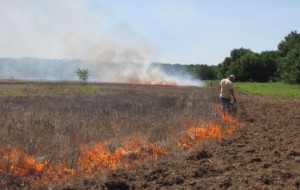Burning hayfields or pastures can reduce insect and disease pressure the following summer. Timely late winter burns (late February, early March) can offer several benefits to a hay or livestock producer.
Burning off thatch kills annual weed seeds and any insect eggs present in the dead grass. Reducing the thatch layer increases sunlight penetration to new growth in the spring and helps warm up soil temperatures quicker, resulting in earlier green-up in the fields.
Also, the first cutting of hay will be cleaner since old weeds and thatch were removed during burning. Burning also releases nutrients into the soil.
Remember to contact the local Florida Forest Service office to apply for a burn permit and have adequate fire-lines around your fields. Notifying neighbors about the burn plans will avoid unnecessary calls to the local fire department.
It will cost around $10.00 per acre on average to hire a certified burner to manage and direct a field or pasture burn. For more information read the following UF/IFAS publication Prescribed Burning Regulations in Florida
- What are the Benefits of Freezer Beef? - August 27, 2021
- Fire Management in a Silvopasture System - March 19, 2021
- Game Cameras for Wildlife Monitoring - October 2, 2020

